Trialkyl(vinyl)phosphonium Chlorophenol Derivatives as Potent Mitochondrial Uncouplers and Antibacterial Agents
- PMID: 34396013
- PMCID: PMC8359139
- DOI: 10.1021/acsomega.1c02909
Trialkyl(vinyl)phosphonium Chlorophenol Derivatives as Potent Mitochondrial Uncouplers and Antibacterial Agents
Abstract
Trialkyl phosphonium derivatives of vinyl-substituted p-chlorophenol were synthesized here by a recently developed method of preparing quaternary phosphonium salts from phosphine oxides using Grignard reagents. All the derivatives with a number (n) of carbon atoms in phosphonium alkyl substituents varying from 4 to 7 showed pronounced uncoupling activity in isolated rat liver mitochondria at micromolar concentrations, with a tripentyl derivative being the most effective both in accelerating respiration and causing membrane potential collapse, as well as in provoking mitochondrial swelling in a potassium-acetate medium. Remarkably, the trialkyl phosphonium derivatives with n from 4 to 7 also proved to be rather potent antibacterial agents. Methylation of the chlorophenol hydroxyl group suppressed the effects of P555 and P444 on the respiration and membrane potential of mitochondria but not those of P666, thereby suggesting a mechanistic difference in the mitochondrial uncoupling by these derivatives, which was predominantly protonophoric (carrier-like) in the case of P555 and P444 but detergent-like with P666. The latter was confirmed by the carboxyfluorescein leakage assay on model liposomal membranes.
© 2021 The Authors. Published by American Chemical Society.
Conflict of interest statement
The authors declare no competing financial interest.
Figures

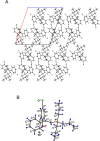
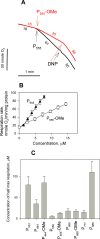
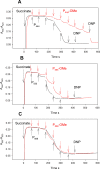
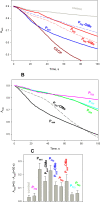
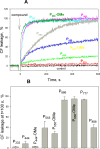



Similar articles
-
Synthesis of Triphenylphosphonium-Linked Derivative of 3,5-Ditert-butyl-4-hydroxybenzylidene-malononitrile (SF6847) via Knoevenagel Reaction Yields an Effective Mitochondria-Targeted Protonophoric Uncoupler.ACS Omega. 2024 Feb 29;9(10):11551-11561. doi: 10.1021/acsomega.3c08621. eCollection 2024 Mar 12. ACS Omega. 2024. PMID: 38496966 Free PMC article.
-
Zwitterionic Protonophore Derived from 2-(2-Hydroxyaryl)alkenylphosphonium as an Uncoupler of Oxidative Phosphorylation.Bioconjug Chem. 2019 Sep 18;30(9):2435-2443. doi: 10.1021/acs.bioconjchem.9b00516. Epub 2019 Aug 16. Bioconjug Chem. 2019. PMID: 31374173
-
Alkyl esters of 7-hydroxycoumarin-3-carboxylic acid as potent tissue-specific uncouplers of oxidative phosphorylation: Involvement of ATP/ADP translocase in mitochondrial uncoupling.Arch Biochem Biophys. 2022 Oct 15;728:109366. doi: 10.1016/j.abb.2022.109366. Epub 2022 Jul 22. Arch Biochem Biophys. 2022. PMID: 35878680
-
Alkyl-substituted phenylamino derivatives of 7-nitrobenz-2-oxa-1,3-diazole as uncouplers of oxidative phosphorylation and antibacterial agents: involvement of membrane proteins in the uncoupling action.Biochim Biophys Acta Biomembr. 2017 Mar;1859(3):377-387. doi: 10.1016/j.bbamem.2016.12.014. Epub 2016 Dec 21. Biochim Biophys Acta Biomembr. 2017. PMID: 28011176
-
Uncouplers of oxidative phosphorylation.Environ Health Perspect. 1990 Jul;87:213-8. doi: 10.1289/ehp.9087213. Environ Health Perspect. 1990. PMID: 2176586 Free PMC article. Review.
Cited by
-
Bisphosphonium Amphiphiles Yield Insights into Gram-Negative Bacterial Disinfectant Resistance and Cell Membrane Interactions.ACS Omega. 2025 Jun 5;10(23):25076-25083. doi: 10.1021/acsomega.5c03308. eCollection 2025 Jun 17. ACS Omega. 2025. PMID: 40547653 Free PMC article.
-
Fifty Years of Research on Protonophores: Mitochondrial Uncoupling As a Basis for Therapeutic Action.Acta Naturae. 2022 Jan-Mar;14(1):4-13. doi: 10.32607/actanaturae.11610. Acta Naturae. 2022. PMID: 35441048 Free PMC article.
-
Antistaphylococcal Activities and ADME-Related Properties of Chlorinated Arylcarbamoylnaphthalenylcarbamates.Pharmaceuticals (Basel). 2022 Jun 5;15(6):715. doi: 10.3390/ph15060715. Pharmaceuticals (Basel). 2022. PMID: 35745634 Free PMC article.
-
Synthesis of Triphenylphosphonium-Linked Derivative of 3,5-Ditert-butyl-4-hydroxybenzylidene-malononitrile (SF6847) via Knoevenagel Reaction Yields an Effective Mitochondria-Targeted Protonophoric Uncoupler.ACS Omega. 2024 Feb 29;9(10):11551-11561. doi: 10.1021/acsomega.3c08621. eCollection 2024 Mar 12. ACS Omega. 2024. PMID: 38496966 Free PMC article.
-
Penetration of Triphenylphosphonium Derivatives through the Cell Envelope of Bacteria of Mycobacteriales Order.Pharmaceuticals (Basel). 2023 May 2;16(5):688. doi: 10.3390/ph16050688. Pharmaceuticals (Basel). 2023. PMID: 37242470 Free PMC article.
References
-
- Antonenko Y. N.; Avetisyan A. V.; Bakeeva L. E.; Chernyak B. V.; Chertkov V. A.; Domnina L. V.; Ivanova O. Y.; Izyumov D. S.; Khailova L. S.; Klishin S. S.; Korshunova G. A.; Lyamzaev K. G.; Muntyan M. S.; Nepryakhina O. K.; Pashkovskaya A. A.; Pletjushkina O. Y.; Pustovidko A. V.; Roginsky V. A.; Rokitskaya T. I.; Ruuge E. K.; Saprunova V. B.; Severina I. I.; Simonyan R. A.; Skulachev I. V.; Skulachev M. V.; Sumbatyan N. V.; Sviryaeva I. V.; Tashlitsky V. N.; Vassiliev J. M.; Vyssokikh M. Y.; Yaguzhinsky L. S.; Zamyatnin A. A. Jr.; Skulachev V. P. Mitochondria-targeted plastoquinone derivatives as tools to interrupt execution of the aging program. 1. Cationic plastoquinone derivatives: synthesis and in vitro studies. Biochemistry (Moscow) 2008, 73, 1273–1287. 10.1134/S0006297908120018. - DOI - PubMed
LinkOut - more resources
Full Text Sources

